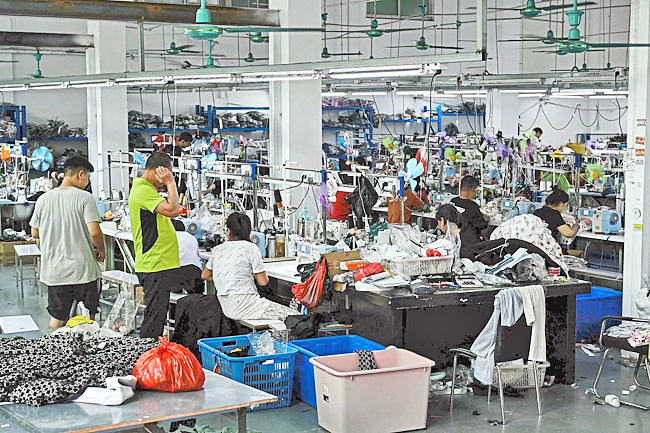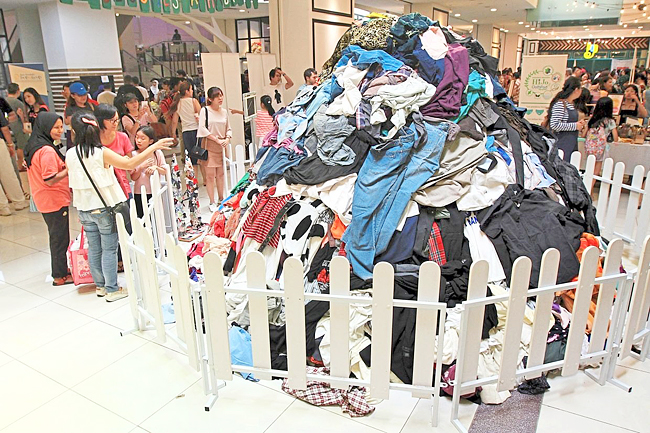ANN/THE STAR – Sustainability encompasses the entire lifecycle of textile and clothing production, extending all the way to their ultimate disposal. An emerging environmental concern revolves around the end-of-life phase of clothing items, as a growing trend of quicker discarding leads to a significant volume of materials ending up in landfills daily.
For instance, the Ellen Macarthur Foundation, a research entity dedicated to zero waste and a partner of the United Nations Environment Programme (UNEP), has reported that every second, a truckload of discarded textiles finds its way into landfills or undergoes incineration somewhere around the globe.
Some experts estimate that individuals are now purchasing about 60 per cent more clothing while wearing them for only half as long.
This phenomenon is often attributed to the ‘fast fashion’ trend, which promotes frequent style changes and encourages continuous buying. Additionally, there is a market for inexpensive, short-lived clothing, which further contributes to our disposable culture.
UNEP highlights the annual Black Friday sales, particularly popular in North America and gaining traction among online shoppers in Malaysia.
This event serves as a reminder of the importance of reevaluating our consumption and waste habits, and the impact that waste has on the environment.


At last November’s UN Climate Conference (COP27) in Egypt, the UNEP and the not-for-profit Global Fashion Agenda (GFA) held an event on ‘Circular systems for a net positive fashion industry’, which saw industry leaders discussing routes towards a circular economy so that there will be less waste, less pollution and greater reuse and upcycling, as well as more recycling.
The clarion call for fashion industry stakeholders is that there needs to be holistic and concrete targets to create an industry that is benign or even net positive for the planet – undoubtedly an ambitious undertaking because net positive would mean nothing less than pivoting towards an industry that gives back more to the world than it takes out.
To show the way, UNEP is producing a roadmap towards fashion sustainability, and one step on it is for the textile value chain to embrace the circular economy and its result, zero waste. At the same time, UNEP is also attempting to shift the narrative to one that considers the role of consumption with an eye on sustainability.
Other than contributing to the waste stream and using toxic chemicals in their processes, the fashion industry has also been accused of a litany of bad practices, including abusing human rights by turning a blind eye to the poor working conditions of the people who actually make the clothes.
Often, these are people in less developed countries working for global brands.
FASHION IN THE SPOTLIGHT
The fashion industry is responding. For one, the industry-led GFA fosters industry collaboration on sustainability in fashion, pledging to drive action by mobilising, inspiring, influencing and educating all stakeholders.
GFA acknowledges that the industry is linked to around four per cent of global carbon emissions, that 80 per cent of clothes are either incinerated or sent to landfills, while 35 per cent of microplastics in the oceans come from microfibres shed by synthetic fibres.
At globalfashionagenda.org, GFA said the fashion industry has much to do on the road to sustainability.
“As of today (2018), the sustainability pulse of the industry is weak. The newly developed global Pulse Score, a health measure for the sector, is only 32 out of 100. The industry is not yet where it could and should be.
“The spread of performance is also quite large. The best performers on sustainability are the very big players as well as some mid-sized, family owned companies, while over half of the market, mainly small to medium-sized players, has shown little effort so far.
“The rest of the industry is somewhere in between. This is confirmed by the Pulse Survey, where two-thirds of polled fashion executives have not made environmental and social factors guiding principles for their companies’ strategy.”
Outside the industry, regulators and activists are also piling on the pressure, with the UN addressing the impact of fashion by mentioning it as a driver for the implementation of the Sustainable Development Goals (SDGs are a collection of 17 interlinked objectives designed to serve as a shared blueprint for peace and prosperity for people and the planet).
In July 2018, at an event hosted by the UN Economic Commission for Europe (UNECE) in New York City, several UN organisations agreed to set up a UN Alliance on sustainable fashion, with President of the UN Economic and Social Council Marie Chartadová stressing that the fashion industry needs to change gear.
Coming under the authority of the UN’s General Assembly, the Economic and Social Council coordinates the UN’s economic and social work and the UN family of organisations.
These different UN organisations came together to discuss how the momentum for sustainable fashion should be sustained, with UNECE executive secretary Olga Algayerova saying that it is high time to make sustainability the next fashionable trend and Executive Director of the UN Office for Partnerships Robb Skinner said, “All organisations working on issues related to the fashion industry will benefit from increased collaboration.”
The various UN agency heads contend that the complexity of fashion supply chains makes it even more apparent that working in silos will not be enough to achieve the SDGs, and that there is there is an urgent need to capitalise on the chorus of calls for change by many state leaders during the UN High-Level Political Forum (HLPF) on sustainable development.
HLPF is a subsidiary body of both the UN General Assembly and the UN Economic and Social Council and is responsible for the entire organisation’s policy on sustainable development.
REGIONAL HUB
Closer to Malaysia, the Singapore Fashion Council (SFC) has put in place its Fashion Sustainability programme with the intention of positioning the country as the regional capital for innovative solutions for fashion sustainability.
“With the fashion industry being one of the largest polluters in the world, there is urgency to implement solutions to begin mitigation of environmental impacts,” it said on its website, sgfashioncouncil.org.sg.
“To achieve this, the SFC continuously adds to and collaborates with our network of sustainability-focused companies, organisations, government agencies, consumers and communities from across the entire fashion value chain.
“As part of our work, we join hands with collaborators to develop tool kits for businesses to adopt, introduce talent capability development programmes, and work with the industry to identify common pain points and possible solutions to explore and capitalise on opportunities in the green economy.
“We also work with schools and communities to build awareness and capabilities in sustainability,” it said.
THE SITUATION IN MALAYSIA
Solid waste management consultant in Malaysia Dr Theng Lee Chong said fabric in the waste stream is not a huge problem here, though he acknowledges that the fast fashion issue is still relevant given that people largely embrace disposable culture.
“I won’t say fabric/textile is a problem in the Malaysian waste stream. As we can see from the waste composition, this type of waste contributes to only about three per cent (by weight) of total waste generated,” said Dr Theng, who is the national coordinator for waste management collaboration projects between the local government development ministry and japan’s environment ministry, among his other roles in the field.
“Instead, I would say fabric/textile is a challenging issue in the reuse market, where people usually discard used clothes into recycling bins, drop off centres or give them to charity organisations and so on.
“However, if you ask those non-governmental organisations (NGOs) and recycling centre operators, they will be able to tell you how much fabric/textile they have received, and the problems they are facing in cleaning and sorting them all. And then, some of these are sold to Third World countries. “There are also some recycling activities for waste fabric or textiles in place, but not to a very large extent,” said Dr Theng, who felt that it is quite common for more things to be thrown away without being reused or upcycled as a country develops.
“With higher standards of living and buying power, the throwaway mentality becomes more significant.
“This throwaway mentality applies not only to clothing items, but also to things that are more harmful to the environment (if improperly disposed of) such as electronic and electrical products.”
Co-founder in 2019 of the Selan-gor-based Zero Waste Earth Store Jaclynnd Wong Yin Thing said there is definitely room to reduce textile and fabric waste in Malaysia.
“We can reduce the amount through circular fashion via fabric upcycling and recycling, the second-hand market, repair and maintenance, repurposing, and renting (rather than owning).
“On the part of consumers, they can use environmentally friendly laundry detergent, learn to repair fabric, buy quality fabric, and to subject certain types of fabric to fewer wash cycles to make them last longer.”
Sustainability-focused writer Khor Hui Min said there is a plethora of things people can do to prolong the life of clothes.
“These include fashion swaps, giving and buying from second- hand shops and charities, and repairing damaged clothing or items,” said Khor, who occasionally partakes in clothing swap activities.
The Internet helps somewhat in the giving and/or exchanging culture, with examples including Wong’s Zero Waste Earth Store Malaysia as well as the Beli Nothing project or Buy Nothing project, both on Facebook.
To date, there are easily several dozen of these groups where gifting takes place.
Khor argued that Malaysians need to get past a mental stumbling block when it comes to wearing used clothing.
“It’s important for that shift in mindset, to accept the wearing of used clothing as normal and, in fact, beneficial. It is time we shed the stigma surrounding wearing clothes that come from unknown sources (such as buying from a thrift store),” she said. – Meng Yew Choong




